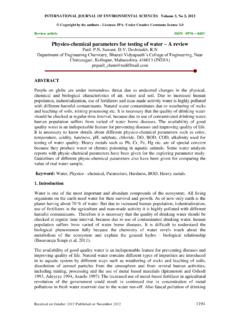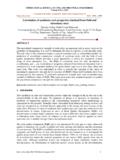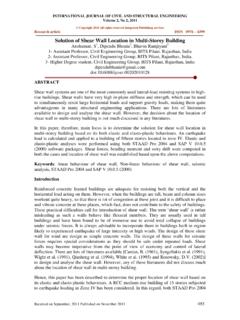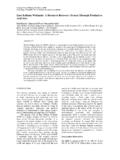Transcription of Status of solid waste generation and management …
1 INTERNATIONAL JOURNAL OF ENVIRONMENTAL SCIENCES Volume 6, No 6, 2016 Copyright by the authors - Licensee IPA- Under Creative Commons license Research article ISSN 0976 4402 Received on January 2016 Published on May 2016 1173 Status of solid waste generation and management practice in kolkata municipal corporation , West Bengal Sk Ajim Ali Research Scholar, Department of Geography, AMU, Aligarh ABSTRACT This paper presents a general over view of the current solid waste (MSW) management in kolkata municipal corporation (KMC), West Bengal.
2 solid waste management is one of the most challenging issues in urban cities at present scenario, which are facing a serious pollution problem due to the generation of huge quantities of solid waste . The KMC generates more than 3520 MT solid waste per day. As a group, households are the single largest generators of municipal waste in kolkata . On an average maximum solid waste generated from commercial around and market area and minimum from institution around It has been projecting that KMC will generate near about 8805 MT solid waste per day in 2035. But on an average has been estimated that approximately only 700 ton of these generated waste are collected and stored in every day.
3 So, there exist a huge gap between waste generation and waste disposal, which create several environmental problems. The main objective of this paper is to discuss on existing situation of current solid waste management (SWM) in KMC. This paper is basically based on secondary sources of data which is collected mainly from manual on kolkata municipal corporation . It was found that the solid waste management in KMC appears to be inadequate and needs to be upgradation. Higher priority needs to be assigned to the management of solid waste by local authority and system approach needs to be adopted for optimizing the entire option of SWM. Orga (2003) stated that municipal bodies are unable to provide a 100% efficient system and even are not able to reach the efficiency of 60%.
4 This is not because the municipality is not doing their work properly or due to work negligence, but it is due to old conventional working methods which need to be upgraded with modern technologies. Keywords: KMC, solid waste , waste management practice, sources and quantities, recommended waste management practice 1. Introduction The term solid waste usually relates to all kinds of waste , whether generated during the extraction of raw materials, the processing of raw materials into intermediate and final products, the consumption of final products, or other human activities, including residential, institutional, commercial, agricultural, and special health care, household hazardous wastes, sewage sludge.
5 It generates at a rate of 450 500 g per capita per day in developing countries. According to a United Nations Conference on Human Settlement report, one third to one-half of solid waste generated within most cities in low- and middle-income countries waste disposal and management is intended to reduce adverse effects of waste on health, the environment or aesthetics. solid waste management has become a considerable issue, in addition other environmental problems, especially for densely populated cities in developing countries. In my study I mainly confine my view on current Status of solid waste Status of solid waste generation and management practice in kolkata municipal corporation , West Bengal Sk Ajim Ali International Journal of Environmental Sciences Volume 6 2016 1174 management in KMC which is a primitive megacity of West Bengal.
6 This area is situated at the bank of river Ganga. Therefore, augmentation of the solid waste management facilities in term of collection and disposal is the issue of concern. But their operation & maintenance in a sustainable manner by urban local bodies would require huge capital investment, introduction of latest technologies which are cost effective. Public-Private Partnership (PPP) in waste management and introduction of appropriate waste management practices are needed in order to prevent urban waste causing environmental pollution and health hazards. 2. Significance Modernization, technical advancement and increase in global population created rising in demand for food and other essential. This has resulted to rise in the amount of waste being generated daily by each household.
7 The problems associated with handling of solid waste have increased at an alarming rate over the past few years. The focus of the study is on the current Status of solid waste management practices in KMC in order to make suitable recommended sustainable management practices. So that KMC can make plan for unwanted or useless materials generated from combined residential industrial and commercial activities around it. 3. Objectives The key objectives of the present study are 1. To study the present source and quantities of solid waste and their generation around kolkata municipal corporation . 2. To highlight the physical and chemical properties of Municipality refuse. 3. To focus an overview on current waste management practices.
8 4. To emphasize on Public- Private Partnership (PPP) in waste management by initiating appropriate waste management practice in order to prevent urban waste causing environmental pollution and health hazards. 5. To suggest and make recommended methods in aim of sustainable waste management . 4. Methodology The study has been accomplished mainly through secondary data. The secondary data has been collected from various Government and Non-government sources. Numerous reports of Central Pollution Control Board (CPCB), kolkata municipal corporation (KMC) and West Bengal Pollution Control Board (WBPCB) have been consulted for the purpose. Apart from these a number of articles from various journals related to the topic have been considered.
9 Lastly, the secondary data has been computed, compiled and represented through cartograms followed by analysis and interpretation. Study area (Description of KMC) The State of West Bengal has 20 districts among which the city of kolkata holds a place of significance both in the field of administration and commercial activities. The city is under the administrative jurisdiction of kolkata municipal corporation . The kolkata municipal corporation has a total area of 205 sq. km (census 2011) with a geographical extension of 22 27'N to 22 39'N latitude and 88 14'E to 88 26'E longitude. The territorial jurisdiction of kolkata municipal corporation (KMC) has been divided into 15 Boroughs consisting of 141 Status of solid waste generation and management practice in kolkata municipal corporation , West Bengal Sk Ajim Ali International Journal of Environmental Sciences Volume 6 2016 1175 municipal wards.
10 Spatially the city can be divided into North, East, Central and South kolkata . The district of Haowra lies to the North-West, North 24 Parganas on the Northern and North-Eastern side and South 24 Parganas on the South-Eastern and South-Western side. The River Hugli flows through Western part of the city. It is 120 km from Bay of Bengal and stands on the eastern Bank of River Hooghly (Figure 1). Table 1: KMC at a glance Area 205 sq km Climate Humid during summer and pleasant in winter Maximum temperature 40oC Minimum temperature 10o C Average rainfall 1605 mm Total population 44,96,694 (as per 2011) Population density 24,429 sq km Vehicular population million Floating population 60,00,000 per day No. of Borough 15 No. of Wards 141 solid waste generation and disposal per Day 3520 MT/D (as per 20113- 14) Source: KMC, 2011 KOLKATANINDIAWEST BENGALKOLKATAKMC WARDS Figure 1: Location Map of the study area.











